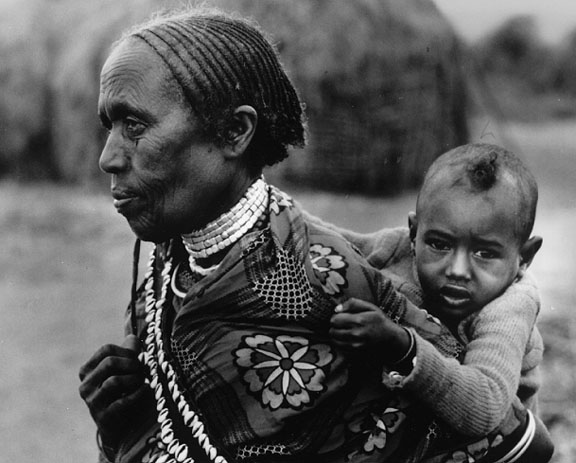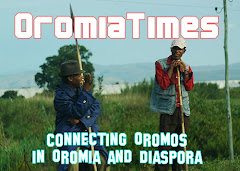By Marc Lacey
The New York Times SATURDAY, MAY 27, 2006
MERKA, Somalia A baby boy with his leg blown off by shrapnel. Corpses in the streets. The wounded writhing in pain in wheelbarrows, the only ambulances around.
Horrible memories have followed those who have fled the war-ravaged Somali capital in recent days for the relative safety of this town 65 kilometers, or 40 miles, down the coast. At night, the evacuees from Mogadishu still dream of the artillery shells that exploded around them day after day. The rat-a-tat of automatic weapon fire they cannot get out of their heads.
"When you witness a one-year-old whose leg has been cut off by a mortar shell it stays with you," said Halima Ahmed, 50, who left Mogadishu two days ago with her 85-year-old mother in a cart hauled by a donkey. "We've witnessed so many things."
The fighting pits Mogadishu's notorious warlords against Islamist leaders attempting to turn the country into a religious state. But for many of the people running for their lives, the fighting is as incomprehensible as so many past wars, a shootout between rival militias in which civilians are the ones bleeding the most.
"I have no idea who is fighting who," said Hadiyo Mohamed, 25, who fled Mogadishu three days ago with three young children. "I was just going about my daily activities as a housewife when shelling began."
The complicated fight began in January, only to escalate as the months have passed. Fueled by arms provided by foreign governments, the battle for power has cost hundreds of lives, even as the leaders on both sides portray themselves as defenders of the people.
"We don't consider either side as good," said Issa Ali, 40, who fled with his wife and three children. "God knows which is the best to rule Mogadishu."
The warlords have ruled Mogadishu for 15 chaotic years, using young gunmen to extract as much revenue as they can from checkpoints, ports and airstrips within their turf. They have struck alliances with business leaders, who pay protection money to enable them to trade with Gulf states.
But Islamic leaders have quietly emerged as a third force, one with huge political, economic and military clout. They have slowly filled a void in anarchic Somalia, creating Islamic schools and courts and providing social services unavailable anywhere else.
Amid the moderate sheiks, however, are hard-liners whom American officials say have formed a small Al Qaeda cell in Mogadishu.
To combat the extremists, American intelligence officials struck an alliance with the warlords, who fashioned themselves into a counterterrorism alliance.
"Clandestine third-country involvement" is what an expert panel convened by the United Nations calls the behind the scenes activity by the American government, without explicitly naming the United States.
A report released this month in New York by the panel suggested that Washington was providing financial support "to help organize and structure a militia force created to counter the threat posed by the growing militant fundamentalist movement in central and southern Somalia."
The situation has some eerie parallels to Afghanistan, where warlords so disillusioned the population that the hard-line Taliban took over and provided safe haven to Al Qaeda. That terrorist link led to the American invasion of Afghanistan after the Sept. 11 attacks on New York and Washington.
Americans are not the only ones involved behind the scenes in Somalia. The UN panel found that Ethiopians have been arming the fledgling government that has convened outside Mogadishu, in the inland town of Baidoa.
To counter Ethiopian influence, the Eritrean government has provided arms of its own, the UN panel said, detailing precise shipments of anti-aircraft, anti- tank and heavy machine gun ammunition as well as machine guns, remote- control bombs and anti-personnel mines provided by each side.
Also accused of violating a UN arms embargo in Somalia are the Italians, accused of shipping trucks and "a number of large, long, sealed boxes" to the transitional government. In addition, Yemen has shipped pickup trucks, military uniforms, military boots to the transitional government, the experts found.
As battling rages on the streets of Mogadishu, the transitional government that was formed after two years of peace negotiations in neighboring Kenya sits on the sidelines. The government has issued declarations calling for an end to the violence, but to little effect.
In fact, four of the chief warlords involved in the fighting hold top-level cabinet posts in the government and have openly flouted calls for them to lay down their arms.
The Islamists have also thumbed their noses at the government, especially its call for a foreign peacekeeping force to bring order to the capital.
But no matter which side eventually wins the fight for Mogadishu, residents fear that peace will not be the result. "Even if one side wins, they will then fight among themselves," said Issa Mohamed Ga'al, who fled fighting in Mogadishu in March.
Subscribe to:
Post Comments (Atom)

















No comments:
Post a Comment